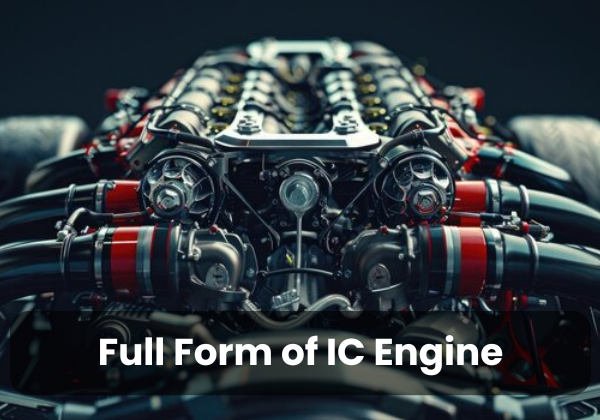Full Form of IC Engine: The term IC engine full form stands for Internal Combustion Engine, a pivotal technology that powers most modern vehicles and machinery. At its core, an IC engine converts chemical energy from fuel into mechanical energy through combustion inside a confined space. This technology revolutionized transportation and industrial applications, making it a fundamental topic in mechanical engineering and automotive studies.
What is an IC Engine?
An Internal Combustion Engine (IC Engine) is a heat engine where the combustion of fuel occurs within a combustion chamber. Unlike external combustion engines (like steam engines), where fuel burns outside the engine, IC engines utilize the direct ignition of fuel-air mixtures to generate power.
How Does an IC Engine Work?
The working principle of an IC engine involves four key stages, commonly known as the four-stroke cycle (Otto cycle for petrol engines and Diesel cycle for diesel engines):
-
Intake Stroke – The piston moves down, drawing in a mixture of air and fuel (petrol engines) or just air (diesel engines).
-
Compression Stroke – The piston moves up, compressing the air-fuel mixture, increasing its temperature and pressure.
-
Power Stroke – A spark plug ignites the compressed mixture (in petrol engines) or fuel is injected and auto-ignites (in diesel engines), causing an explosion that forces the piston down.
-
Exhaust Stroke – The piston moves up again, expelling burnt gases through the exhaust valve.
Types of IC Engines
IC engines are classified based on different parameters:
1. Based on Fuel Used
-
Petrol Engine – Uses gasoline as fuel, relies on spark ignition.
-
Diesel Engine – Uses diesel fuel, operates on compression ignition.
-
Gas Engine – Runs on natural gas or propane.
2. Based on Ignition Method
-
Spark Ignition (SI) Engine – Uses a spark plug (e.g., petrol engines).
-
Compression Ignition (CI) Engine – No spark plug; fuel ignites due to high compression (e.g., diesel engines).
3. Based on Stroke Cycle
-
Four-Stroke Engine – Completes the power cycle in four piston strokes.
-
Two-Stroke Engine – Completes the power cycle in two strokes, commonly found in smaller vehicles like motorcycles.
4. Based on Cylinder Arrangement
-
Inline Engine – Cylinders arranged in a straight line.
-
V-Engine – Cylinders arranged in a V-shape (e.g., V6, V8 engines).
-
Opposed or Boxer Engine – Cylinders placed horizontally opposite each other.
Applications of IC Engines
IC engines are widely used in various industries due to their efficiency and adaptability:
-
Automobiles – Cars, bikes, trucks, and buses.
-
Aviation – Small aircraft and drones.
-
Marine Transport – Ships and boats.
-
Power Generation – Backup generators and portable power sources.
-
Agriculture – Tractors and irrigation pumps.
Advantages and Disadvantages of IC Engines
Advantages
-
High Power-to-Weight Ratio – Produces significant power relative to size.
-
Portability – Used in vehicles and mobile machinery.
-
Quick Start-Up – No need for preheating (unlike steam engines).
-
Fuel Efficiency – Modern engines optimize fuel consumption.
Disadvantages
-
Pollution – Emits greenhouse gases (CO₂, NOx) and particulate matter.
-
Noise & Vibration – Generates significant noise during operation.
-
Non-Renewable Fuel Dependency – Relies on fossil fuels (petrol, diesel).
Future of IC Engines
With increasing environmental concerns, IC engines are evolving:
-
Hybrid Engines – Combining IC engines with electric motors for better efficiency.
-
Alternative Fuels – Biofuels, hydrogen, and CNG are being explored.
-
Stricter Emission Norms – Advances like catalytic converters and turbochargers reduce pollution.
Conclusion
Understanding the IC engine full form (Internal Combustion Engine) and its working principles is essential for students pursuing mechanical and automotive engineering. Despite challenges like emissions, IC engines remain indispensable in transportation and industry. As technology progresses, cleaner and more efficient variants will continue to shape the future of power generation.
For further learning, explore Aakash Institute’s specialized courses in engineering and technology to gain deeper insights into IC engines and their advancements.
IC Engine (Internal Combustion Engine) FAQs
1. What is the full form of IC engine?
The full form of IC engine is Internal Combustion Engine, where fuel combustion occurs inside a closed chamber to generate mechanical power.
2. What are the main types of IC engines?
IC engines are primarily classified into:
-
Petrol engines (Spark Ignition)
-
Diesel engines (Compression Ignition)
-
Two-stroke & Four-stroke engines
-
Gas engines (CNG/LPG)
3. How does an IC engine differ from an EC engine?
IC engines (Internal Combustion) burn fuel inside the engine (e.g., car engines), while EC engines (External Combustion) burn fuel outside to heat a working fluid (e.g., steam engines).
4. What are the common applications of IC engines?
IC engines power:
-
Automobiles (cars, bikes)
-
Generators
-
Aircraft (piston-engine planes)
-
Marine vessels
-
Agricultural machinery (tractors, pumps)
5. Why are IC engines being replaced in some applications?
Due to:
-
Pollution concerns (CO₂ emissions)
-
Rise of electric vehicles
-
Stricter emission norms
However, advanced IC engines with hybrid tech and alternative fuels remain relevant.

